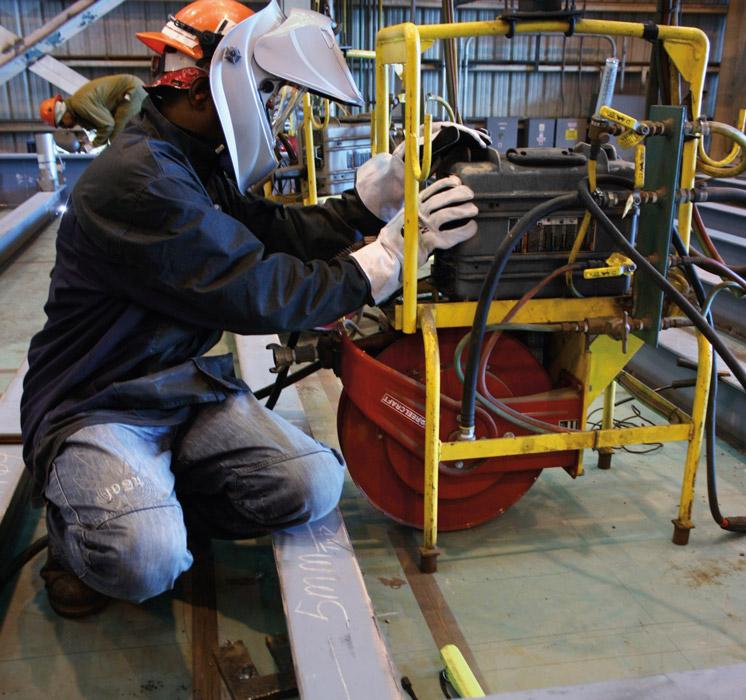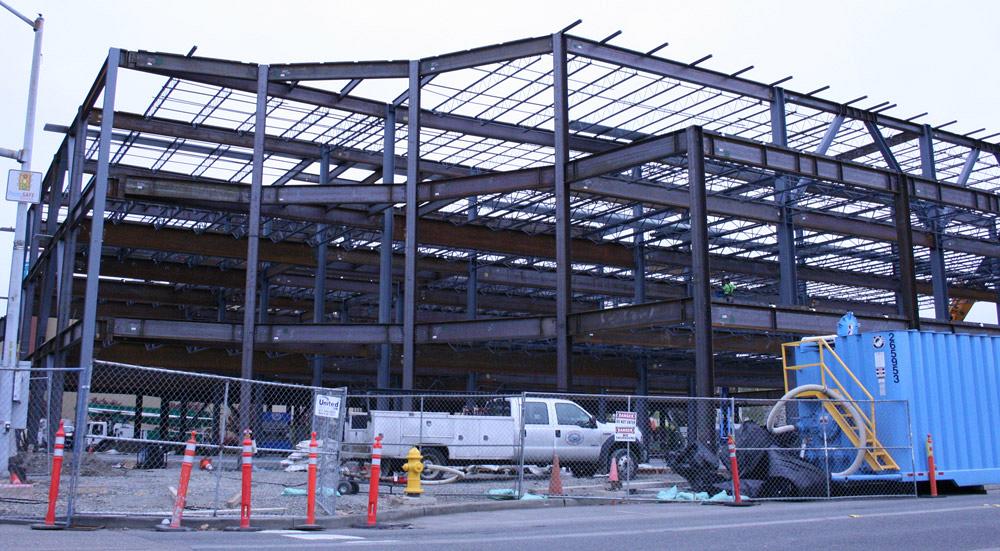Contributing Writer
- FMA
- The Fabricator
- FABTECH
- Canadian Metalworking
Categories
- Additive Manufacturing
- Aluminum Welding
- Arc Welding
- Assembly and Joining
- Automation and Robotics
- Bending and Forming
- Consumables
- Cutting and Weld Prep
- Electric Vehicles
- En Español
- Finishing
- Hydroforming
- Laser Cutting
- Laser Welding
- Machining
- Manufacturing Software
- Materials Handling
- Metals/Materials
- Oxyfuel Cutting
- Plasma Cutting
- Power Tools
- Punching and Other Holemaking
- Roll Forming
- Safety
- Sawing
- Shearing
- Shop Management
- Testing and Measuring
- Tube and Pipe Fabrication
- Tube and Pipe Production
- Waterjet Cutting
Industry Directory
Webcasts
Podcasts
FAB 40
Advertise
Subscribe
Account Login
Search
Full remote control at the weld joint can improve productivity, safety
- By John Leisner
- December 21, 2015
- Article
- Arc Welding

One option available for gas metal arc welding includes a feeder with remote control technology — with wire feed speed and voltage control — through the positive and negative weld cables. No control cable is required.
Companies are always searching for ways to improve efficiency, profitability, and safety. In a welding operation, these can be especially critical considerations. Following best practices and offering proper training to welders are key steps in reaching these goals. In addition, equipment and technology advancements can help meet quality and productivity goals, while also keeping welders safer on the job.
Remote control welding technology offers benefits for industries such as construction, shipbuilding, and heavy fabrication. This technology is especially helpful on large job sites where welders have to travel a significant distance between the power source and the weld joint.
With available remote control systems, these operators gain full control of weld settings and parameters at the weld joint. They can make the proper adjustments to produce the best results — no matter the weld position or joint configuration. This ability reduces or eliminates trips back and forth to the power source to make adjustments. Fewer trips not only reduce welder movement on expansive and sometimes cluttered job sites, but also allow more time for welding and eliminate the need to "get by" with less-than-optimal parameters. It is easier to obtain consistent weld quality and to reduce time and money spent on rework.
Challenges of Previous Control Systems
Higher weld quality and more arc-on time can make companies more efficient and profitable, which makes remote control technology an attractive option. However, the limitations of traditional remote control technologies have kept most companies from choosing it. Corded remote control systems, for example, require an additional control cable that runs to the power source for adjusting the voltage from the weld joint. Control cables can contain multiple wires wrapped in a bundle, so they are expensive to purchase, maintain, and repair.
Traditional wireless remote controls often have distance limitations, typically 200 to 300 feet from the power source. Functionality of these systems can often be interrupted by job site obstructions.
Because of these issues, portable wire feeders that do not need a control cable often are suitable for applications that require welding at an extended distance from the power supply. However, until recently these portable feeders did not provide the ability to control voltage at the weld joint. This led welders to make do with a single set of welding parameters that might be considered good enough for each joint configuration, rather than travel back and forth to the power source to make the proper adjustments, a scenario that ultimately harms quality and productivity.
A New Remote Option
More advanced remote control technology eliminates these issues. These systems operate using only the existing weld cables — without a separate control cable — and provide complete control of wire feed speed, voltage, and process selection at the weld joint, without line-of-sight or distance limitations.
Eliminating control cables eliminates the costs to purchase, repair, and replace them. It also reduces downtime spent troubleshooting issues associated with damaged cables, minimizes the number of cables on a job site that require maintenance, and lessens the rolling and unrolling of cables at the beginning and end of each shift or day.
With the ability to see the exact voltage and amperage and adjust as needed, welders have full control at the weld joint. This makes it easier to manipulate the weld puddle size and shape to produce the highest-quality welds, regardless of welding position.
With full control at the joint, operators also can avoid making compromises in wire stickout, travel speeds, and position that could lead to weld defects or rework. And because voltage-sensing wire feeders display the actual voltage and current measured at the arc, the welder can compare the real-time reading to weld-setting presets. This feature lets operators continually monitor parameters to ensure the machine delivers the appropriate power to the arc for more consistent weld quality.

Remote control welding technology offers benefits for industries such as construction, shipbuilding and heavy fabrication. This technology is especially suitable for large job sites where welders have to travel a significant distance between the power source and the weld joint.
Fewer trips to the power source to make adjustments also affects productivity by increasing arc-on time. Having full control of welding parameters at the weld joint ensures that the most productive weld settings for the welding position are being used, allowing for the completion of more welds in less time.
When welders spend less time navigating large, crowded job sites, they are not only more productive, but also safer because they are exposed to fewer trip and fall hazards. Some operators must work high up in the air at the spot of the weld, so safety is further improved if they can reduce the number of times they must climb up or down a ladder or steps.
Limiting the need to travel back and forth on an expansive job site also lessens operator fatigue.
Gaining an Edge
When it comes to running a safe, efficient, and profitable welding operation, it's important to look at all aspects that contribute to that success. From establishing the best welding parameters to reducing operator fatigue by minimizing unnecessary job site movement, it is possible to gain greater quality and productivity.
Remote control technology can help. It is especially useful in industries where deadlines are particularly tight; full remote control at the weld joint can help operations complete projects on time and on budget, which makes them more competitive in the marketplace.
About the Author
About the Publication
Related Companies
subscribe now

The Welder, formerly known as Practical Welding Today, is a showcase of the real people who make the products we use and work with every day. This magazine has served the welding community in North America well for more than 20 years.
start your free subscription- Stay connected from anywhere

Easily access valuable industry resources now with full access to the digital edition of The Fabricator.

Easily access valuable industry resources now with full access to the digital edition of The Welder.

Easily access valuable industry resources now with full access to the digital edition of The Tube and Pipe Journal.
- Podcasting
- Podcast:
- The Fabricator Podcast
- Published:
- 04/16/2024
- Running Time:
- 63:29
In this episode of The Fabricator Podcast, Caleb Chamberlain, co-founder and CEO of OSH Cut, discusses his company’s...
- Trending Articles
Sheffield Forgemasters makes global leap in welding technology

ESAB unveils Texas facility renovation

Engine-driven welding machines include integrated air compressors

The impact of sine and square waves in aluminum AC welding, Part I

Compact weld camera monitors TIG, plasma processes

- Industry Events
16th Annual Safety Conference
- April 30 - May 1, 2024
- Elgin,
Pipe and Tube Conference
- May 21 - 22, 2024
- Omaha, NE
World-Class Roll Forming Workshop
- June 5 - 6, 2024
- Louisville, KY
Advanced Laser Application Workshop
- June 25 - 27, 2024
- Novi, MI


























